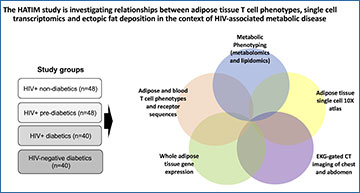Researchers at Vanderbilt University Medical Center have published the largest single-site adipose tissue atlas known to date. A tissue atlas is a comprehensive, detailed map of the cells, structures and molecules within a specific tissue or organ, designed to support open-ended study.
The research team’s Human Adipose Tissue Atlas is based on subcutaneous fat specimens gathered from 59 VUMC research participants living with HIV. The team used single-cell RNA sequencing to identify cell types and gene expression patterns.
The team reports findings from the atlas in a recent issue of Frontiers in Immunology. The study was led by infectious diseases specialists Celestine Wanjalla, MD, PhD, assistant professor of Medicine, Samuel Bailin, MD, assistant professor of Medicine, and John Koethe, MD, associate professor of Medicine.
Single-cell RNA sequencing reveals complex cellular composition
of subcutaneous white adipose tissue
(A) Schematic overview of study design. Twenty HIV+ non-diabetic, 19 HIV+ prediabetic, and 20 HIV+ diabetic participants underwent abdominal subcutaneous adipose tissue harvesting with liposuction. Tissue was processed with collagenase and dissociated. Single-cell suspensions from each participant were hashed and labeled with CITE-seq antibodies before multiplexing in groups of four. 10x libraries were generated using the Chromium platform and sequenced on the Illumina NovaSeq 6000. The bioinformatic pipeline included demultiplexing, quality control, dimensional reduction and clustering, and transcriptional analysis. (B) Uniform Manifold Approximation and Projection (UMAP) of 162,552 cells from 59 individuals after removal of doublets and quality control, with manual annotation of cell clusters based on canonical gene markers. (C) UMAP after harmony integration grouped by disease status showing successful integration; HIV+ non-diabetic (green), HIV+ prediabetic (blue), and HIV+ diabetic (yellow). (D) Gene expression projected onto the UMAP identifying major cell types including stromal (COL1A2, CCDC80), vascular (CLDN5, ACTA2), myeloid (CD68, CD1C), and T cell and natural killer cells (CD3E, NKG7). (E) Boxplot showing the proportion of major cell categories (stromal, vascular, lymphoid, and myeloid) as a percentage of total cells split by disease status (n = 59) (HIV+ non-diabetic, green; HIV+ prediabetic, blue; HIV+ diabetic, yellow). The horizontal black line represents the median, the box shows the lower and upper quartile limits and the whiskers are 1.5x the interquartile range. * p < 0.05, ** p < 0.01; ns, not significant.
Subcutaneous white adipose tissue has emerged as a critical regulator of systemic metabolic homeostasis, and it happens to be easily enough collected using liposuction. The atlas covers the gamut of insulin sensitivity in people living with HIV, including specimens from 20 subjects without diabetes, 19 with prediabetes, and 20 with diabetes.
The report reads like a compendium, appearing to leave no stone unturned. Among the highlighted findings, the researchers found that glucose intolerance is accompanied by a rise in lipid-associated macrophages and effector memory T cells, and a reduction in the macrophages found in small spaces around blood vessels. As glucose intolerance increased, the team observed a rise in expression of genes related to inflammation and lipid processing in multiple cell types. In analyzing how cells communicate with each other, the study found increased signaling related to proinflammatory responses and the formation of fibrous connective tissue.
Persons with HIV have higher rates of cardiometabolic diseases compared to HIV-negative persons with similar traditional risk profiles, note the study’s authors.
“People with treated human immunodeficiency infection provide an important model for studying the role of the innate and adaptive immune system in the development of cardiovascular and metabolic diseases,” said Koethe.
Bailin adds, “These data highlight a central role of adipose tissue in metabolic disease and the complexity of cell interactions and gene expression changes that give rise to functional differences in adipose tissue in persons with HIV with metabolic disease. Some of the changes are shared with HIV-negative individuals with metabolic diseases.”
Wanjalla notes, “With the atlas available online, it serves as a valuable shared reference for future studies investigating adipose tissue-related mechanism of metabolic disease and therapeutic interventions.”
Source – Vanderbilt University Medical Center
Availability – The Human Adipose Tissue Atlas is available at: https://vimrg.app.vumc.org/
Bailin SS, Kropski JA, Gangula RD, Hannah L, Simmons JD, Mashayekhi M, Ye F, Fan R, Mallal S, Warren CM, Kalams SA, Gabriel CL, Wanjalla CN, Koethe JR. (2023) Changes in subcutaneous white adipose tissue cellular composition and molecular programs underlie glucose intolerance in persons with HIV. Front Immunol 14:1152003. [article]





